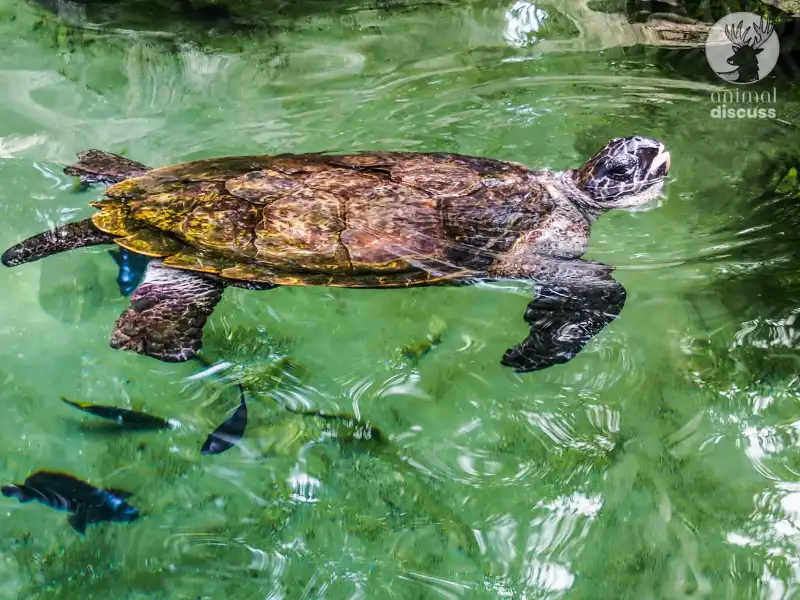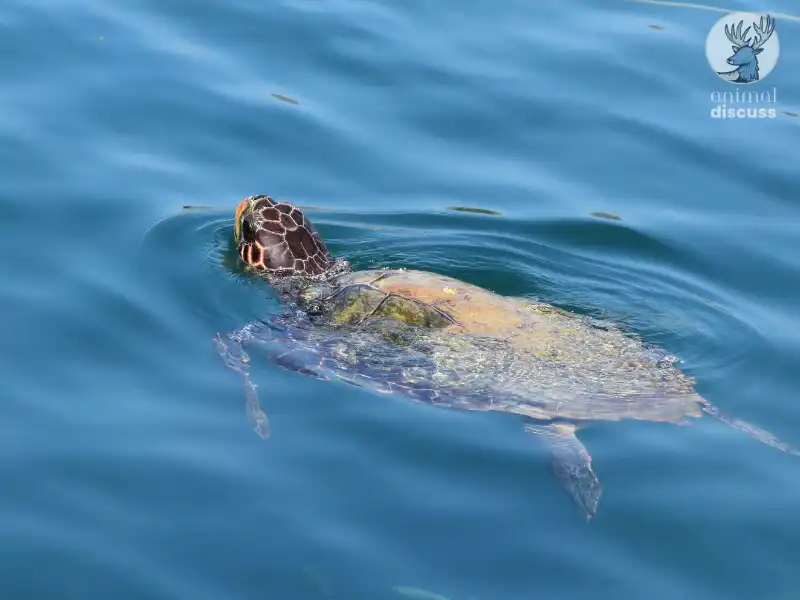Do you know Loggerhead Sea turtles have a combination of diets in which they are both omnivores and carnivores? Well, they are. But it has a twist. Because the younger ones are omnivores, but the adult ones are carnivores.
Such a diversity in diet, right? Moreover, their adaptations with the mouth part have made them carnivores so that they can eat those hard shells. Quite rebellious!
I am here today to talk with you about the bigger-head loggerhead sea turtles’ food and diet. I’ll cover all the aspects in this article for you. Want to know about it? Then check it out.
What Do the Hatchling and Juvenile Loggerhead Sea Turtles Eat? (Reference)
The hatchling and juvenile loggerhead sea turtle diet is completely different from the adult ones. Because the younger ones are omnivores, who depend both on plants and animals for their survival.

So, the hatchlings consume small animals that live in the floating mats named sargassum. In that place, they spend their early developmental years, which is the juvenile era of loggerhead sea turtles.
At that stage, they started living in coastal areas in the western Atlantic. So, during that time the food they eat from lagoons, estuaries, bays, and river mouths, and live on drinking shallow coastal waters.
It is even noted that juveniles mostly consume bottom-dwelling invertebrates like whelks, different mollusks, sea urchins, etc.
If you want to know more details about “loggerhead sea turtle“, check out.
What Does an Adult Loggerhead Sea Turtle Eat? (Reference) (Reference)
Now comes the main part. Around 50,000 loggerhead sea turtles exist in the world. What is the food habit of this huge bulk amount of adult loggerhead sea turtles? Well, it’s carnivores.
Starting with, the mostly bottom-dwelling invertebrates which are
- Whelks
- Mollusks
- Horseshoe crabs
- Sea urchins
All of these are crucial food sources for them which are easily consumable by them through their powerful jaws. Sometimes they also consume –
- Fish
- Jellyfish
- Seagrass
- Fish that are dead or small in size are their target
Other than that, jellyfish are their target when they are at the surface area. And about seagrass, it’s quite occasional for them to consume it. But sadly, loggerhead sea turtles according to a University of Tokyo report are the 17% of turtles who mistakenly consume plastic, thinking of it as food.
How Do Loggerhead Sea Turtles Forage for Their Food? (Reference 1) (Reference 2)
You have already identified at what stage the food habits of loggerhead sea turtles vary. I will now exhibit the diverse and amazing strategies of this loggerhead sea turtle through which they target their prey.
Using their vision
Beginning with the hatchlings which have an inborn tendency to move towards the direction of light. And about adults, they have an even distribution of rods and cones.

It signifies that they can see properly in bright light. Moreover, they are able to see near-ultraviolet, blue-green and yellow light. For which they can easily detect the radiance of bioluminescent prey.
So, when the mollusks are resting on the seafloor or the crabs like invertebrates swimming around, they detect them easily because of this amazing vision. Their keen eyesight allows them to spot easily by swimming close to the bottom.
Using their bodies
Other than their vision, these amazing sea creatures have powerful jaws. Powerful enough to crush the hard shells of the prey even if it is mollusks or crabs. They are bestowed with a beak-like mouth for this activity.
Their flippers are another powerful way to forage for their prey. Through their flippers, they hold the prey and take it aside by swiping. Thus, they can tear off bits or leverage against the essential parts of their food. Like scallops.
Accordingly, by using flippers, they maneuver their prey by stirring up the sand on the seafloor to flush out those deep-down invertebrates buried like clams.
Overall, we can now definitely see how capable a loggerhead sea turtle is when it comes to foraging for their food. Their remarkable vision, physical strength, powerful jaws and beak let them forage the food easily.
How Do Environmental Factors Help Loggerhead Sea Turtles Forage? (Reference 1) (Reference 2) (Reference 3)
Loggerhead sea turtle foraging food is supported by environmental factors too. Yes, even nature has its own way to help these creatures. Starting with the temperature of the water.
What loggerhead turtles consume and how much movement there is in the water are both affected by tides. Warmer water can draw in prey, who are then easier to spot.
Moving on, according to the ecological perspective, the eastern and western Mediterranean Seas are important areas for foraging. That is because the northern part has a higher biodiversity level. Both the nutrient level and the abundance of jellyfish, crustaceans, etc. prey items are found there.
That’s when clearer water from the freshwater helps them to locate prey easily. Likewise, when the ocean currents are strong, they concentrate the food sources in particular areas.
It again becomes easier for the hatchlings to locate the food and survive. But the opposite happens when there are weak currents, so foraging is challenging.
As we know, benthic invertebrates are eaten by them which are often seen in sandy or flat seafloors. But when the invertebrates are attached to the rocks, vegetation gets trickier to find.
Similarly, one of the environmental factors is the presence of sargassum seaweed, which is a floating habitat for turtles. As it gives them the chance to hide in it while looking for prey. Even sometimes give abundant food sources too.
How Do Loggerhead Sea Turtles Adapt to The Seasons with Food Scarcity? (Reference)
Although loggerhead sea turtles face periods of food scarcity, they have developed numerous remarkable adaptations to cope with these changes. Those are –
Migration
Throughout the year, adult loggerhead turtles cover vast distances, often exceeding thousands of kilometers. This allows them to remain in areas with abundant food sources throughout the year.

Finding the optimal spots to eat is made easier for them by their ability to monitor changes in water temperature and food availability.
Being carnivores
As mentioned earlier, loggerheads are carnivores, meaning they can eat different types of food sources depending on what’s available. This dietary flexibility allows them to adjust their foraging behavior based on seasonal variations in prey abundance.
If their preferred prey becomes scarce, they can switch to other available food sources, such as different types of invertebrates, fish, or even some seagrass.
Through conserving energy
If loggerhead turtles are unable to locate food, they exhibit a more sedentary habit in order to conserve energy. To achieve this, they spend less time on activities, such as swimming, and seeking food; rather, spend time relaxing.
Do Loggerhead Sea Turtles Drink Water? (Reference)
No. Unlike humans and many terrestrial animals, loggerhead sea turtles do not require access to fresh water for their hydration needs. The seawater they consume provides all of their water needs.
Then, how about the salinity of the water? Does it affect them? No. That’s the wonderful part. Salt glands are located behind their eyes and are unique to these animals. When they consume seawater, these glands assist them expel any excess salt.

And tears are actually a powerful saline solution produced by the salt glands and released through the tear tubes. This is how their bodies eliminate the excess salt that is too much for them to process.
Besides, a portion of the water they require comes from the foods they consume, which may contain water. So, loggerhead sea turtles may not be able to drink fresh water, but they are rather good at obtaining the saltwater they require through ingenious means.
Frequently Asked Questions
I am now about to share some ideas about different questions that often you guys want to know about loggerhead sea turtles. Check them out –
1. Do loggerhead sea turtles eat sponges?
Yes, they do. As they are opportunistic feeders often, they consume it. Other than that, what happens is that they consume it by thinking it is mollusks or any other invertebrates.
2. Do loggerhead sea turtles migrate for food?
Definitely, they do. In Japan, there is a nesting ground for them, but they don’t spend their entire lives there. One group migrated to Baja California, Mexico to hunt food which was approximately 7456 miles.
Conclusion
Loggerhead sea turtles’ ability to forage for food shows they can go miles after miles just in search of food. But as their diet is not so limited, they always have an option to shuffle around among foods.
Plus, the ability to adapt has given them the power to survive without food for days. However, disposable products and products made of plastic are thrown into the sea causing the sea turtles to consume mistakenly and hazard their health. That’s why we need to be very careful in keeping the sea areas plastic-free.

